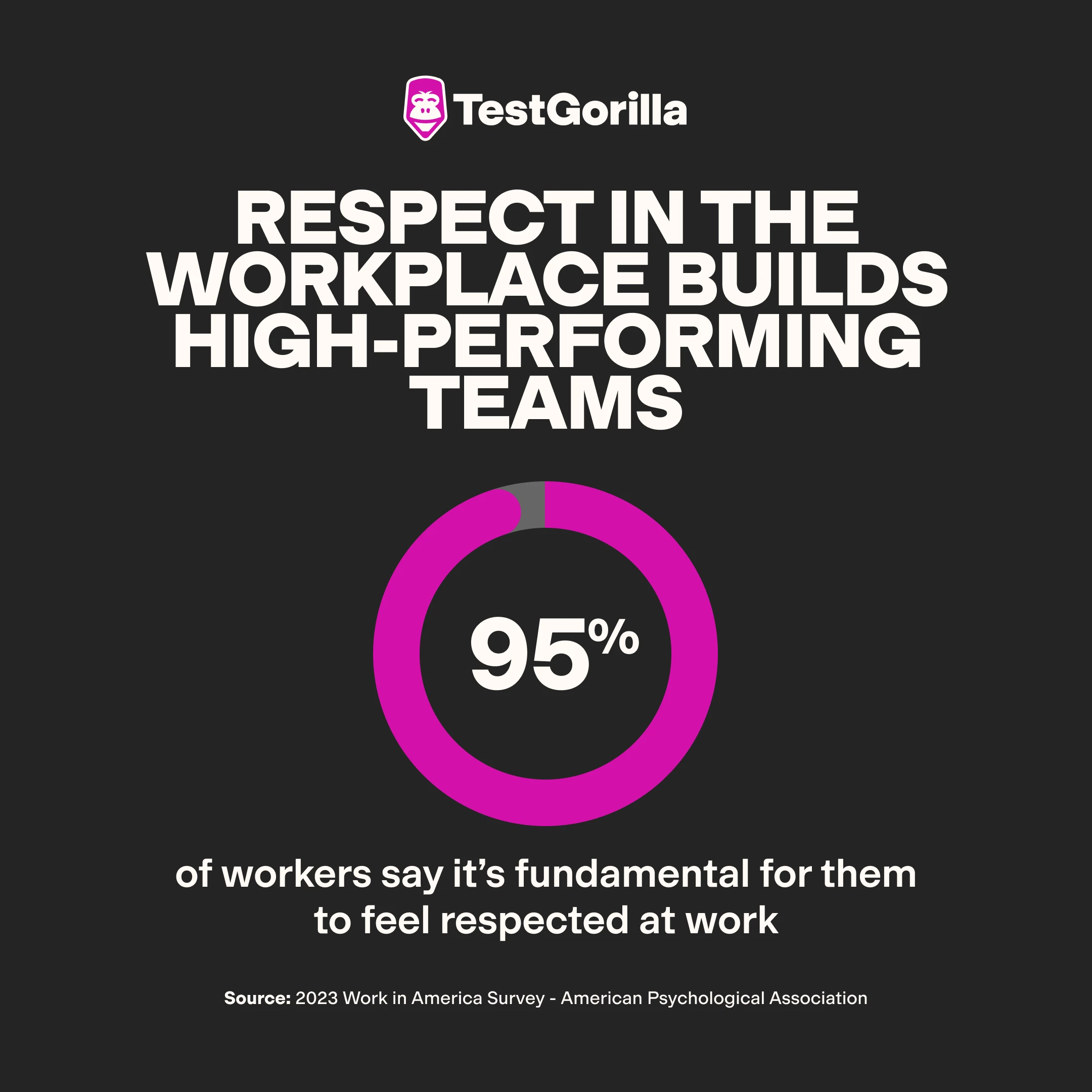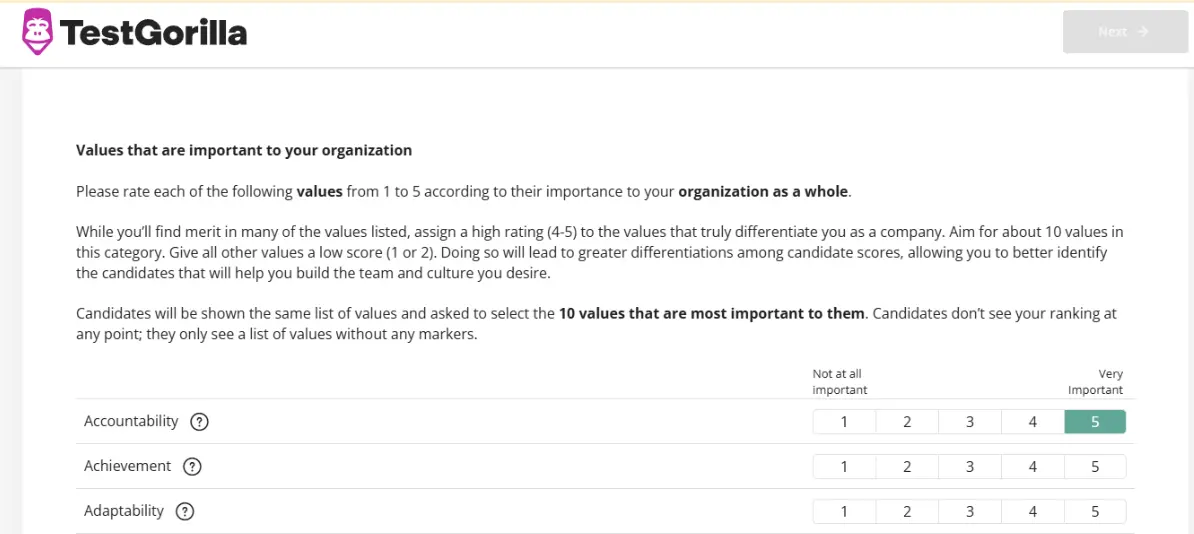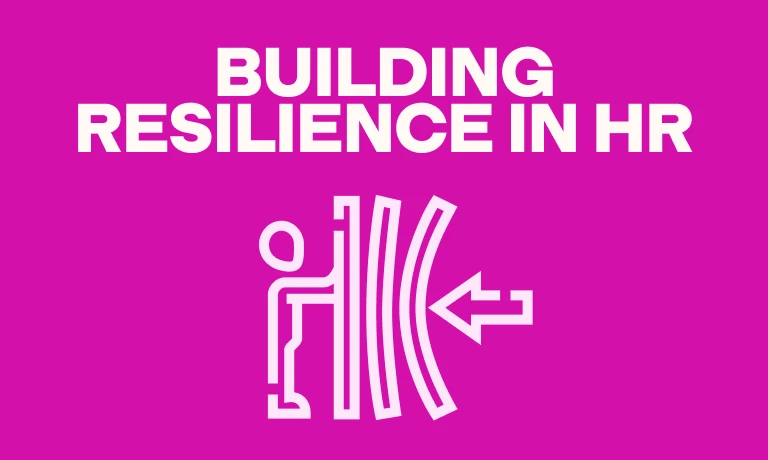Build mutual respect with skills-based practices
Mutual respect in the workplace is crucial for building a high-performing team. Employees who feel respected are more engaged, productive, and satisfied in their roles.
In fact, the American Psychological Association found that 95% of workers say it’s fundamental for them to feel respected at work.
Unfortunately, it’s easy to lose focus on mutual respect when building your workplace hierarchy. Regularly testing candidates’ skills to ensure they can work in a team effectively tends to take a backseat when you’re focusing on productivity and structure.
In this article, we show you how to build mutual respect at work by adding robust tactics to your hiring strategy, management styles, and employee development efforts.
What is mutual respect?
Mutual respect is a reciprocal form of respect between multiple people. Respect is caring about someone else’s mental health, viewpoints, and personal boundaries. It can also include admiring their qualities, skills, and achievements. Clearly, mutual respect means more than simply tolerating someone different from you. It’s about committing to treating people courteously, understanding their worldview, and recognizing their value.
When people practice mutual respect, they demonstrate high levels of emotional intelligence and acknowledge that everyone is different.
This creates environments where everyone is welcomed, treated fairly, supported, and given equal opportunities to grow.
Why is mutual respect in the workplace important?
The importance of mutual respect lies in its role in creating a healthy company culture.
A healthy company culture has respectful employees with open communication, empathy, and mutual trust. They’re honest, courteous, and tolerant of their coworker's boundaries.
Such employees actively contribute to the holistic growth of your company by investing in the success of the whole team.
Building respect among your staff has several benefits for your business:
Promotes productivity and cooperation: Employees in a mutually respectful workplace are more cooperative. They can work effectively with people with diverse experiences and backgrounds, improving overall team performance.
Improves efficiency and reduces stress: The employee wellbeing in your workplace is crucial for worker efficacy. Workers who feel respected are less stressed and more motivated to maximize their skills and traits.
Increases employees’ satisfaction and engagement: Being respected in the workplace raises employees’ satisfaction, which can increase engagement and reduce employee turnover.
A lack of respect in the workplace breeds negative behavior.
Name-calling, bullying, gossiping, disregarding feelings, and other forms of disrespectful behavior destroy harmony and cooperation. An employee who doesn’t feel respected might even disengage from their role.
The conflict, poor communication, and teamwork issues that result from this type of work environment can impact your company’s productivity and profits.
Respectful behavior in the workplace is easier to cultivate when you hire employees with the right personality traits and skills to support your workplace culture. This makes talent assessment crucial to building a mutually respectful workplace.
Skill assessments can even help you identify ways to adjust your training methods to nurture mutually respectful employees.
Hire and develop mutually respectful teams with TestGorilla
Skills tests focusing on emotional intelligence, problem-solving, adaptability, and communication skills help you find employees who help foster a culture of mutual respect.
The best insights on HR and recruitment, delivered to your inbox.
Biweekly updates. No spam. Unsubscribe any time.
How to foster mutual respect in the workplace: 7 tips
As an HR professional at your organization, it’s your job to foster mutual respect in the workplace. Everything you do, from the methods you use to assess candidates joining your team to how you interact with employees, influences the culture you build.
The following seven strategies show you how to promote mutual respect at work, boosting the success, satisfaction, and productivity of your employees.
How to foster mutual respect: In summary
Tip for fostering mutual respect | In short |
Hire to build the culture you want | Add to a better company culture by hiring culturally diverse, respectful workers. Hiring workers to “fit” into your existing culture only promotes biases and disrespectful behaviors. |
Lead by example | The most important part of making respect “mutual” is giving it before expecting to receive it. Be the pioneer that shows your employees what respect looks like through positive and constructive feedback. |
Actively listen to employees | Employees feel respected when they know they’re being heard. Empathize and actively respond to what they’re saying to build respect between you. |
Celebrate employees’ achievements | Regularly affirm and reward employees' contributions in various ways to make them feel valued and motivated, creating a positive feedback loop of recognition within the team. |
Get to know your employees | Invest in learning about each employee’s personal and professional goals and use tools like personality tests to better understand their traits and motivations to tailor leadership approaches. |
Provide opportunities for growth | Address the need for more development by offering regular learning opportunities, new projects, and mentorship programs, which enhance productivity and let team members know you value their future. |
Encourage colleagues to voice their opinions and ideas | Create a supportive, people-first culture by actively seeking and valuing feedback from all employees, even those leaving the company, to improve processes and performance continually. |
1. Hire to build the culture you want
Building mutual respect in the workplace starts with hiring employees who can contribute to the culture you want to build. Mutual respect doesn’t stem from simply hiring employees who can “fit” into your organization’s pre-established culture.
Instead, it’s about hiring a diverse selection of employees who can positively augment your existing workforce with the right behaviors and values. The easiest way to ensure you’re hiring for “culture add” is to use the right assessments when evaluating candidates. Our Culture Add test evaluates your candidates’ potential to contribute to your company’s culture and success:
You can customize the test based on your company’s values and the requirements of your open roles. This ensures you screen candidates objectively and effectively to guarantee they can support the culture you want to build.
2. Lead by example
Great leaders set a positive example for all employees by being the first to show respect to their colleagues. That begins with showing kindness, using appropriate language when communicating with employees, and sharing feedback.
Employees rely on feedback to guide their behavior. Positive feedback reinforces positive behavior. Negative feedback, though difficult to hear, can help teams identify weaknesses and unlock their full potential.
When you give critical feedback, focus on making it constructive. Workers are human beings, so even if you’re unhappy with someone’s output, add something positive about their performance and share ideas on improving. This helps preserve motivation and morale.
When leaders share feedback and direction in this way, other staff members mirror the same approach. This leads to a company-wide feedback loop enhanced by mutual respect.
3. Actively listen to employees
The ability to actively listen to and understand another person is vital to fostering mutual respect. Hearing your employees out means sitting down with them and focusing on what they’re telling you.
Listening isn’t just crucial to workplace respect; it’s essential to gathering valuable insights from your team.
This enables you to learn about all the problems and challenges your teams face and how you can overcome them by working collaboratively.
Don’t interrupt an employee or dismiss their ideas. Try to see their point of view, even if it differs from yours, and acknowledge what they have to say.
Listening to your team members and actively responding to their input shows respect and builds a healthy relationship between leader and follower.
4. Celebrate employees’ achievements
Always try to affirm the value of each team member, especially when they have gone above and beyond in completing their tasks. Nurturing a feeling of appreciation makes employees feel like their efforts are worthwhile.
Openly praise team members’ contributions before their peers and reward them appropriately. Experiment with different ways to show appreciation, such as broadcasting congratulations messages on team chat apps, sharing thank you notes, or distributing rewards like bonuses.
When you show staff respect this way, they feel more motivated. They may also feel more comfortable showing recognition to their peers, leading to a better feedback loop.
5. Get to know your employees
Everyone is unique, so respecting your team members doesn’t always mean treating them exactly the same. People have different ideas about what “respect” means to them, so you need to meet them where they’re at.
Invest in learning more about each employee. Identify their professional and personal goals. Get to know “who” they are and find common ground.
You could even invite employees to take personality tests for insights into their traits and mindset. The TestGorilla DISC personality test, for instance, can help you define the core characteristics of different employees.
This can help team leaders better understand what drives their employees and which staff members may work better together on group projects. You could build on these insights with a Leadership & People Management test to identify the best project leaders.
Once you understand your employees, you can contextualize their actions, behaviors, strengths, and weaknesses. Knowing their hopes, dreams, and ambitions enables you to form good relationships and achieve mutual respect in the workplace.
Learn about your team members with TestGorilla
Personality tests can give you valuable insight into the most important traits of your employees and candidates. Get started for free with our Big 5 (OCEAN) personality test!
6. Provide opportunities for growth
According to SHRM, 55% of employees need more training to perform effectively at work, and 32% feel they don’t have access to enough learning opportunities.
Offering regular learning and development opportunities not only makes your teams more productive but also cultivates respect between team members and management.
Giving employees a chance to take on new projects, collaborate with cross-functional teams, and participate in mentorship opportunities makes them feel respected. These opportunities make employees feel valued for their skills and their potential within your company.
By showing that you care about their future and see more to them than the skills they currently offer, growth opportunities can produce respectful relationships between you and your team members while also improving their self-esteem, which drives their motivation.
Plus, investing and engaging in the professional growth of your team members means they feel more loyal to your organization. Many employees quit when they feel like their jobs have stagnated, but what if they know growth is always on the horizon?
7. Encourage colleagues to voice their opinions and ideas
Building mutual respect in the workplace revolves heavily around your ability to build a “people-first” culture. Leaders and team members must constantly show their peers they’re present and ready to support them.
As a leader, this means showing your employees that you’re ready to listen to them about any problems – big or small. Nothing upholds a culture of mutual respect within the workplace better than an open-door policy.
If employees know you’re open to listening to their ideas, they feel more comfortable sharing insights. These insights could help you discover opportunities to enhance your processes and boost business performance.
Remember to source feedback from everyone on your team, too. Even when a person leaves your team, ask politely for their insights on how your company can improve through an exit survey.
Exiting employees have nothing to lose, so asking them for areas of improvement is your best chance for truly honest feedback. Former employees are likely to share the same opinions as current employees, so implementing the changes would be appreciated by everyone.
Build mutual respect in the workplace with skill assessments
Building a workplace that promotes mutual respect is no easy task. If you want to create a mutually respectful workplace, you must start fostering this culture from the moment you add new employees to your team.
Embracing skills-based hiring strategies to hire candidates based on the “culture add” they can bring to your team helps you build a diverse workplace of employees working effectively together towards mutual goals and objectives.
Conducting personality, culture-add, and communication skills tests both before you hire employees and after you onboard them into your workplace promotes a mutually respectful workplace, helping you avoid major challenges such as workplace conflicts and increased talent turnover. For instance, Libab increased employee retention by up to 90% by screening for skills and culture with TestGorilla
Achieve the same results by signing up for our Free Forever plan for immediate access to valuable tests related to communication, personality, and problem-solving skills.
Alternatively, take our product tour or request a demo for insights into our advanced selection of tests.
Mutual Respect FAQs
Do you still have a few questions about building mutual respect at work? Find the answers to three commonly asked questions below:
How do you promote mutual respect in the workplace?
You can promote mutual respect at work by hiring for cultural add, leading by example, developing and implementing clear feedback and communication mechanisms, and showing appreciation and recognition to employees.
What are examples of mutual respect in the workplace?
Mutual respect examples in the workplace include demonstrations of active listening and empathy, employees actively avoiding gossip and conflicts, and business leaders showing recognition and appreciation to all team members.
What does mutual respect between employees look like?
When employees show mutual respect to one another, they recognize the value of every person they interact with, listen to their insights, understand their opinions, and are cordial and kind with their responses.
You've scrolled this far
Why not try TestGorilla for free, and see what happens when you put skills first.





















